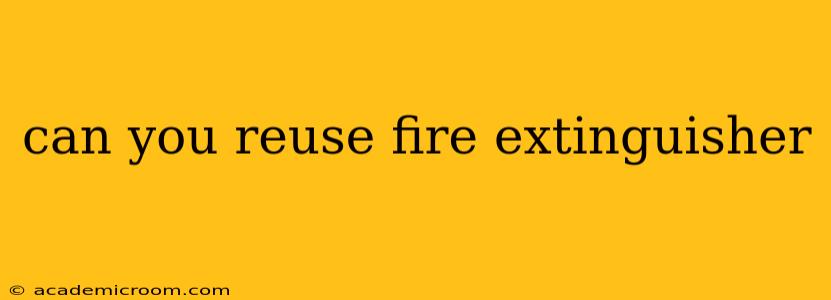Can You Reuse a Fire Extinguisher?
The short answer is: sometimes, but it's generally not recommended and often illegal to attempt yourself. Whether or not you can reuse a fire extinguisher depends on several crucial factors, and improperly handling a used extinguisher can be dangerous. This article will explore the nuances of fire extinguisher reuse, addressing common questions and concerns.
What Happens When a Fire Extinguisher is Used?
When you discharge a fire extinguisher, you deplete its pressurized extinguishing agent. This agent, whether it's dry chemical, CO2, foam, or another type, is the crucial element in putting out a fire. Beyond the agent's depletion, the internal pressure is also significantly reduced. Depending on the type of extinguisher, internal components might be damaged or contaminated by the fire itself.
Can I Refill a Fire Extinguisher Myself?
No, absolutely not. Refilling a fire extinguisher is a specialized job requiring specific training, equipment, and certifications. Attempting to refill it yourself is incredibly dangerous and could lead to serious injury or even death. The internal pressure is extremely high, and improper handling can cause the extinguisher to explode. Additionally, many jurisdictions have regulations prohibiting individuals from refilling fire extinguishers.
How Can I Get a Fire Extinguisher Refilled or Serviced?
The proper procedure involves contacting a certified fire extinguisher service company. These companies have the necessary expertise, tools, and safety protocols to inspect, refill, and re-certify your fire extinguisher. They will perform a thorough inspection to ensure that the extinguisher is in good working condition and hasn't sustained damage that would render it unsafe. They'll then properly refill the extinguisher with the correct agent and re-pressure it to the manufacturer's specifications. They will also apply a new service tag indicating the date of service.
What Happens During a Professional Inspection and Refill?
A professional inspection involves a comprehensive assessment of the fire extinguisher. This includes:
- Visual Inspection: Checking for physical damage, corrosion, leaks, and signs of tampering.
- Pressure Test: Verifying the internal pressure is within acceptable limits.
- Weighing: Determining the amount of extinguishing agent remaining.
- Internal Component Check: Examining internal components for damage or wear.
- Refilling: Replacing the depleted extinguishing agent.
- Recharging: Restoring the internal pressure to the correct level.
- Tagging: Affixing a new service tag with the date of service.
Is it Cheaper to Refill or Replace a Fire Extinguisher?
Refilling is generally cheaper than replacing a fire extinguisher, especially for larger or more specialized models. However, if the extinguisher is significantly damaged or outdated, replacement might be the safer and more cost-effective option in the long run.
How Often Should I Have My Fire Extinguisher Serviced?
The frequency of service depends on the type of extinguisher and its usage. However, annual inspections are generally recommended to ensure the extinguisher remains in optimal working condition.
What are the Legal Ramifications of Improper Fire Extinguisher Handling?
Improper handling or attempting to refill a fire extinguisher yourself can lead to significant legal consequences, including fines and potential liability in case of a fire. Always prioritize safety and use certified professionals for any service or refill needs.
In conclusion, while the components of a fire extinguisher can be reused through professional servicing, attempting to reuse or refill one on your own is extremely dangerous and ill-advised. Always seek the services of a qualified and certified professional to ensure your fire extinguisher is safe and ready for use. Remember, a functioning fire extinguisher is crucial for safety, so prioritize proper maintenance and servicing.
